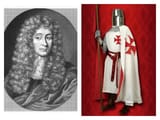Search Results
7/9/2025, 8:13:26 AM
>>509897083
>Ramsay argued that the knight crusaders had ‘agreed upon several ancient signs and symbolic words drawn from the well of religion in order to recognize themselves amongst the heathen and Saracens’, and that ‘these signs and words were only communicated to those who promised solemnly, even sometimes at the foot of the altar, never to reveal them’. The Masonic promise was a ‘bond to unite Christians of all nationalities in one confraternity’ and the essence of Ramsay’s chivalric and muscular freemasonry was ‘after the example set by the Israelites when they erected the second Temple who, whilst they handled the trowel and mortar with one hand, in the other held the sword and buckler’
>Alongside praise for freemasonry’s chivalric and mediaeval origins, Ramsay contended that it epitomised all that was virtuous and Enlightened: a sense of humanity, good taste, fine wit, agreeable manners, and a true appreciation of the fine arts, science and religion. He advanced a holistic concept that appealed to Europe’s elites and validated their self-worth. Ramsay also posited that ‘the interests of the Brotherhood are those of mankind as a whole’ and that ‘the subjects of all kingdoms shall learn to cherish one another without renouncing their own country’. In common with Desaguliers, he saw freemasonry as a movement that could unite individuals ‘of all nations’ and actively proselytised it as such
>Ramsay’s oration was influential but one cannot ignore Europe’s long-standing infatuation with chivalric orders, something that dated back to the Crusades. Among many examples are the Knights Hospitallers (formed in 1099), the Order of Saint Lazarus (1100), the Knights Templars (1118), and the Teutonic Knights (1190). Ramsay’s approach pushed at an open door
>Ramsay argued that the knight crusaders had ‘agreed upon several ancient signs and symbolic words drawn from the well of religion in order to recognize themselves amongst the heathen and Saracens’, and that ‘these signs and words were only communicated to those who promised solemnly, even sometimes at the foot of the altar, never to reveal them’. The Masonic promise was a ‘bond to unite Christians of all nationalities in one confraternity’ and the essence of Ramsay’s chivalric and muscular freemasonry was ‘after the example set by the Israelites when they erected the second Temple who, whilst they handled the trowel and mortar with one hand, in the other held the sword and buckler’
>Alongside praise for freemasonry’s chivalric and mediaeval origins, Ramsay contended that it epitomised all that was virtuous and Enlightened: a sense of humanity, good taste, fine wit, agreeable manners, and a true appreciation of the fine arts, science and religion. He advanced a holistic concept that appealed to Europe’s elites and validated their self-worth. Ramsay also posited that ‘the interests of the Brotherhood are those of mankind as a whole’ and that ‘the subjects of all kingdoms shall learn to cherish one another without renouncing their own country’. In common with Desaguliers, he saw freemasonry as a movement that could unite individuals ‘of all nations’ and actively proselytised it as such
>Ramsay’s oration was influential but one cannot ignore Europe’s long-standing infatuation with chivalric orders, something that dated back to the Crusades. Among many examples are the Knights Hospitallers (formed in 1099), the Order of Saint Lazarus (1100), the Knights Templars (1118), and the Teutonic Knights (1190). Ramsay’s approach pushed at an open door
Page 1
